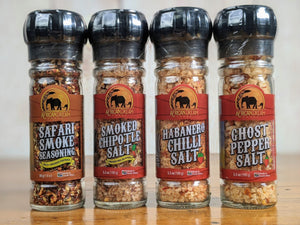Is Peri-Peri Portuguese or African? Unraveling the Origins and Flavors of a Spicy Delight
Apr 04, 2025
Peri-Peri, also known as Piri-Piri or Pili-Pili, is one of the most iconic spicy sauces in the culinary world. Its fiery kick and tangy flavor have inspired countless dishes across the globe. But its origins, ingredients, and journey through cultures are as complex as its flavor. So, let’s dive into the history and flavors of Peri-Peri, unraveling its ties to Africa and Portugal, its significance in South Africa, and the story behind one of the world’s most famous Peri-Peri brands: Nando’s.

What Is Peri-Peri Made Of?
Peri-Peri is a sauce made primarily from African bird’s eye chili peppers, also known as Capsicum frutescens. These small but mighty chilies are native to the African continent and give the sauce its characteristic heat. Traditional Peri-Peri recipes also include a blend of garlic, lemon, vinegar, oil, salt, and various herbs such as oregano or bay leaves. This combination creates a flavor profile that is not just spicy but also tangy, zesty, and aromatic. We have a fun take on this at African Dream Foods, using ghost peppers for a extra kick! Try it out here!
Is Peri-Peri Portuguese or African?
The origins of Peri-Peri are the subject of much debate. The sauce’s roots are a blend of African and Portuguese influences. The story begins in the 15th century when Portuguese explorers landed on the African coast, particularly in Mozambique and Angola. There, they encountered the African bird’s eye chili and quickly adopted it into their cuisine, mixing it with traditional Portuguese ingredients like garlic, lemon, and olive oil.

So, is Peri-Peri Portuguese or African? It’s both. While the chili itself is native to Africa, the Portuguese influence shaped the sauce into what we recognize today. It’s a product of cultural exchange, a fusion of African chilies and Portuguese culinary practices, with each culture contributing to its evolution and flavor profile.
What Is Peri-Peri in South Africa?
In South Africa, Peri-Peri is much more than just a sauce; it’s a cultural staple. South Africans have embraced Peri-Peri as a key element in their cuisine, often using it as a marinade for grilled chicken, seafood, and vegetables. The country’s history and proximity to Mozambique—a place where Peri-Peri is deeply rooted—meant that South Africa naturally became a hub for this spicy delight. Many South African braai (barbecue) traditions incorporate Peri-Peri, showcasing its versatility and prominence in the region's culinary scene.
Is Peri-Peri from Mozambique?
Yes, Mozambique is often cited as the birthplace of Peri-Peri as we know it today. The Portuguese brought their culinary techniques, but it was Mozambican cooks who perfected the sauce, blending local spices and adapting the recipe to their tastes. Mozambican Peri-Peri dishes, particularly grilled chicken and prawns, became famous and are now recognized worldwide. The region’s rich history of using spices and chilies gave Peri-Peri its authentic African flair, making Mozambique a critical part of its story.
Who Created Peri-Peri?
The creation of Peri-Peri is a collaborative effort between African and Portuguese cultures. The African bird’s eye chili, indigenous to the region, was the key ingredient, but it was the fusion of local African cooking techniques and Portuguese culinary methods that gave rise to the Peri-Peri sauce. Mozambican and Angolan cooks are credited with developing the recipes that made Peri-Peri famous, integrating local herbs, citrus, and Portuguese-influenced ingredients to craft the sauce we know and love today.
What Is the Flavor of Peri-Peri?
Peri-Peri is known for its complex flavor profile. At its core, it’s spicy and tangy, but it also offers a smoky, citrusy, and slightly salty taste. The combination of garlic, lemon juice, and vinegar brings a zesty freshness, while the herbs like oregano add an aromatic layer. The heat from the African bird’s eye chili is intense, but it’s balanced by the tanginess and umami flavors that round out the experience. This bold, multi-dimensional flavor is what makes Peri-Peri so beloved worldwide.
Is Nando’s British or South African?
Nando’s is a South African chain with Portuguese-Mozambican roots. It was founded in 1987 in Rosettenville, a suburb of Johannesburg, South Africa, by Fernando Duarte and Robert Brozin. The brand took the Peri-Peri flavors of Mozambique and introduced them to South Africa before eventually expanding worldwide. Although Nando’s is now headquartered in the United Kingdom and has become a global phenomenon, it remains proudly South African in its identity and heritage.
Who Is the Owner of Nando’s?
As of now, Nando’s is privately owned, with Dick Enthoven being one of the main shareholders. The Enthoven family, a South African business dynasty, has been instrumental in expanding Nando’s internationally, turning it into the beloved brand recognized in over 30 countries. Despite its global success, Nando’s stays true to its South African roots, and its identity is deeply tied to the Peri-Peri culture of Africa.
Conclusion: A Shared Legacy
Peri-Peri is a remarkable example of how culinary traditions can transcend borders and blend cultures. While the sauce has African origins—rooted in the chilies native to Mozambique and Angola—the Portuguese influence played a crucial role in its development. Today, Peri-Peri is a symbol of this fusion, celebrated in South African braais, Mozambican street food, and beyond. Whether you enjoy it as a marinade for chicken, a dip for seafood, or a zesty condiment, every bite of Peri-Peri carries a rich, cross-continental history.
So, next time you savor the heat of Peri-Peri, remember that it’s not just a sauce—it’s a story of cultural exchange, innovation, and flavor that belongs to both Africa and Portugal.






